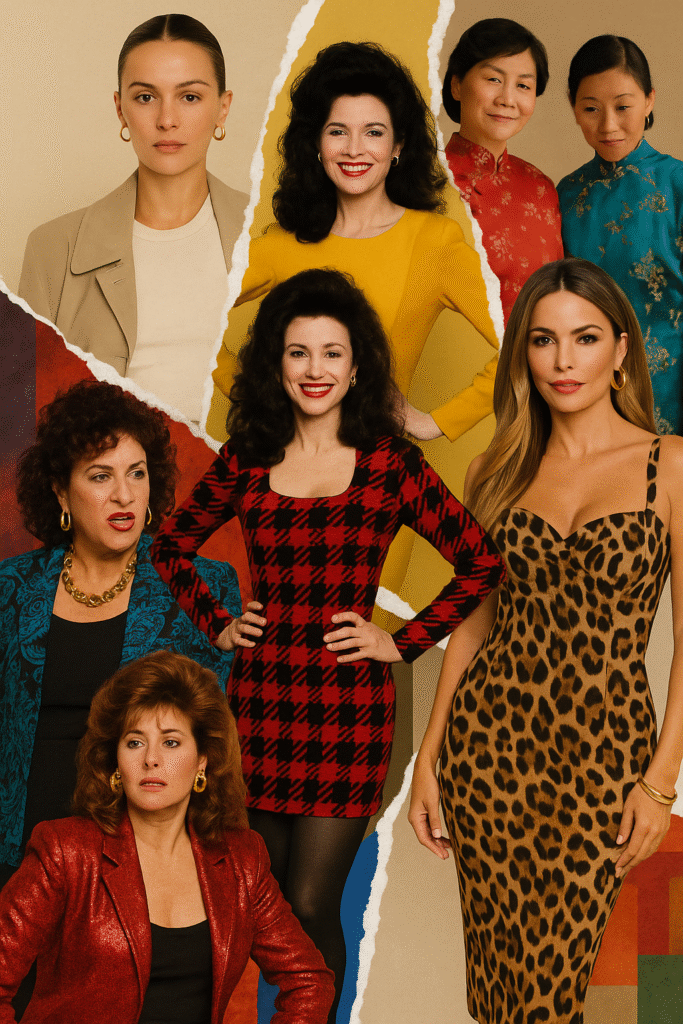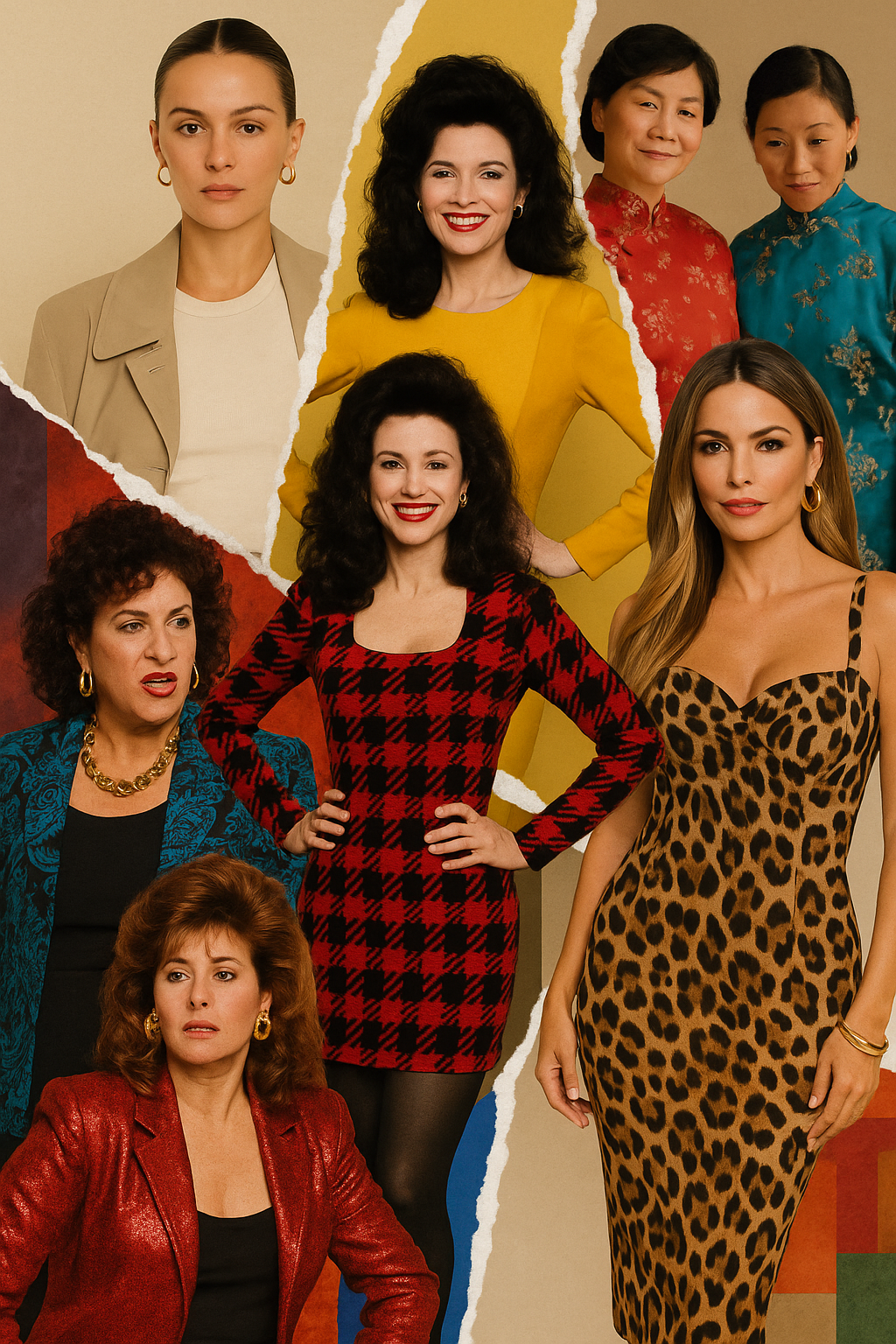
Why the Mob Wife Aesthetic Is Racist, Classist, and Not as Cute as You Think
Scroll through TikTok or Instagram and you’ll see the usual suspects—those highly curated style influencers—now flaunting gold hoops, slicked-back hair, white undershirts, and khakis. Think Hailey Bieber channeling a watered-down version of early-2000s Jennifer López or Zoe Saldaña. Or the resurgence of Mona Lisa Vito from My Cousin Vinny, now rebranded as “maximalism.” When women in non-racialized bodies call this the “Mob Wife Aesthetic,” I can’t help but feel furious.
Suddenly, style markers that were once used to label women like me—ethnic, racialized, and unapologetically bold—as flashy or tasteless are now praised as edgy and fashion-forward. What was once a punchline is now a Pinterest board.
The Whitewashed Aesthetic
These looks are only considered “cool” in mainstream spaces when worn by white women. On Black, Latina, Asian, Arab, or Mediterranean bodies, these same markers are dismissed as gaudy, tacky, or loud. But give them to a white influencer? Suddenly they’re “camp,” “empowered,” and “on trend.”
I’ve been called “ethnic” one too many times for simply daring to wear red lipstick or a bold color. And it enrages me—because I know exactly what that coded language means.
Respectability Politics and the Cult of Beige
I’ve declared a personal war on the cult of “grayge.”
In the rainy sameness of the Pacific Northwest, I wear bright colors. Not just to lift the fog of the Big Dark, but to actively reject the Protestant-rooted aesthetic that treats color as sinful, lustful, or excessive. Beige, white, black, and gray have long been coded as tasteful—but that so-called “neutral” is anything but. It’s a performance of wealth and restraint, not a virtue.
Let’s be honest: those at the top of the social hierarchy decide what counts as good taste. And more often than not, it’s drab, joyless, and exclusionary.
The Iconography of “Too Much”
When bold, expressive fashion from marginalized communities becomes trendy, it’s rarely credited—and never fully accepted unless it’s been scrubbed of context.
The so-called “mob wife” aesthetic pulls directly from characters we grew up with: Fran Fine in The Nanny, Susie Greene in Curb Your Enthusiasm, the wives in Goodfellas, Michelle Pfeiffer’s role in The Fabulous Baker Boys, and the mothers in The Joy Luck Club.
These women weren’t just style icons—they were cultural lightning rods. Their volume—in dress, voice, and personality—was often mocked or seen as threatening. But for them, fashion was armor. It was defiance. It was a strategy for being seen when society wanted them invisible.
Think of the Joy Luck Club mothers: bold silks, gold jewelry, stories folded into every seam. And then their daughters: minimalist, muted, polished into invisibility. Assimilation made tangible.
Trendy Empowerment, Criminal Framing
And then there’s the name: “Mob Wife Aesthetic.”
Not only are these looks stolen, they’re wrapped in a title steeped in criminality. The same style codes that have historically gotten Black and Brown women labeled as dangerous or unprofessional are now glamorized through fictionalized white criminality.
This isn’t empowerment. It’s aesthetic laundering. A rebrand with a wink and a wry smile—all while women who lived this reality were surveilled, sexualized, and shamed.
A white influencer can rock red nails, gold hoops, a tight dress, and slicked-back hair and be called a “queen,” “icon,” or “Carmela-core.” But when I do it? When a Latina or Black woman does it? We’re told to tone it down. To look more “appropriate.”
Let’s call it what it is: a costume worn for clout. One that others were punished for living in.
The Sexualization of Ethnic Bodies
Another unspoken truth behind these trends is that white women who adopt them get to avoid hypersexualization. When Black, Latina, or other racialized women wear tight clothes, gold jewelry, or red lipstick, we’re framed as vamps, as too loud, too extra, or too much.
Take Sofía Vergara: she had to dye her naturally dark blonde hair for Modern Family just to appear “Latina enough”—a reminder that even the idea of looking Latina is filtered through stereotype. Her character, Gloria, was dressed in bold patterns, big jewelry, and bright lips—and was endlessly contrasted with Claire, the buttoned-up white suburban mom in beige tones. On Claire, a fitted dress was “elegant.” On Gloria, it was “too much.”
The same dress, the same silhouette, even the same body will be read differently depending on race, accent, and class. As I’ve illustrated here, fashion isn’t neutral—it’s read. And the reading is loaded.
Reclaiming the Narrative
The “clean girl aesthetic,” “elevated streetwear,” or whatever catchy hashtag the algorithm prefers, is nothing new. These trends are deeply rooted in the aesthetics of chola, Latina, and Black urban communities—East L.A., the Bronx, and beyond. But when white influencers pick them up, they’re sanitized, stripped of context, and called “model off-duty.”
Meanwhile, Black women wearing the exact same thing are still being labeled “ghetto”—a term I find especially repugnant as a Jewish woman.
So I ask you: who gets praised for being bold, for dressing like a boss? And who gets punished for being “too loud”?
Why is it that some get to cosplay our lives while we get punished for daring to express ourselves authentically?
I hope what you take away from this is that style can be joyful, expressive, and liberating—but we owe it to ourselves and to each other to understand the power dynamics behind what gets labeled as “chic.”
And when you see me walking down a rainy Seattle street in my bright yellow coat, gold hoops, big wavy hair, and red lipstick—know this:
I’m not a mob boss wife. I’m a broad with style. And I dress like I mean it.

